
Beginning HTML5 & CSS3 For Dummies
Published by
John Wiley & Sons, Inc.
111 River Street
Hoboken, NJ 07030-5774
www.wiley.com
Copyright 2013 by John Wiley & Sons, Inc., Hoboken, New Jersey
Published simultaneously in Canada
No part of this publication may be reproduced, stored in a retrieval system or transmitted in any form or by any means, electronic, mechanical, photocopying, recording, scanning or otherwise, except as permitted under Sections 107 or 108 of the 1976 United States Copyright Act, without the prior written permission of the Publisher. Requests to the Publisher for permission should be addressed to the Permissions Department, John Wiley & Sons, Inc., 111 River Street, Hoboken, NJ 07030, (201) 748-6011, fax (201) 748-6008, or online at http://www.wiley.com/go/permissions .
Trademarks: Wiley, For Dummies, the Dummies Man logo, Dummies.com, Making Everything Easier, and related trade dress are trademarks or registered trademarks of John Wiley & Sons, Inc. and may not be used without written permission. All other trademarks are the property of their respective owners. John Wiley & Sons, Inc. is not associated with any product or vendor mentioned in this book.
Limit of Liability/Disclaimer of Warranty: The publisher and the author make no representations or warranties with respect to the accuracy or completeness of the contents of this work and specifically disclaim all warranties, including without limitation warranties of fitness for a particular purpose. No warranty may be created or extended by sales or promotional materials. The advice and strategies contained herein may not be suitable for every situation. This work is sold with the understanding that the publisher is not engaged in rendering legal, accounting, or other professional services. If professional assistance is required, the services of a competent professional person should be sought. Neither the publisher nor the author shall be liable for damages arising herefrom. The fact that an organization or Website is referred to in this work as a citation and/or a potential source of further information does not mean that the author or the publisher endorses the information the organization or Website may provide or recommendations it may make. Further, readers should be aware that Internet Websites listed in this work may have changed or disappeared between when this work was written and when it is read.
For general information on our other products and services, please contact our Customer Care Department within the U.S. at 877-762-2974, outside the U.S. at 317-572-3993, or fax 317-572-4002. For technical support, please visit www.wiley.com/techsupport .
Wiley publishes in a variety of print and electronic formats and by print-on-demand. Some material included with standard print versions of this book may not be included in e-books or in print-on-demand. If this book refers to media such as a CD or DVD that is not included in the version you purchased, you may download this material at http://booksupport.wiley.com . For more information about Wiley products, visit www.wiley.com .
Library of Congress Control Number: 2013942775
ISBN 978-1-118-65720-1 (pbk); ISBN 978-1-118-69075-8 (ebk); ISBN 978-1-118-69070-3 (ebk)
Manufactured in the United States of America
10 9 8 7 6 5 4 3 2 1
Introduction
A nyone can create or edit web pages. Crafting such pages doesnt require an especially high IQ or an advanced degree. Creating or editing web pages simply requires a desire to learn and enough gumption to see the process through to its natural end a page visible on the web.
In this book, we reveal the ins and outs of the markup languages that are the webs lifeblood the HyperText Markup Language (HTML) used to capture text, graphics, and other content, and the Cascading Style Sheets (CSS) language used to make web pages look good wherever they appear. Because HTML and CSS are basic building blocks for creating web pages, knowing how to use them adds you to the fold of web authors and content developers.
If youve tried to build your own web pages but found it too daunting, its okay to relax now. If you can dial a telephone or find your keys in the morning, you too can create web pages. No kidding!
This book keeps the technobabble to a minimum and sticks with plain English whenever possible. Besides plain talk about hypertext, HTML, and the web, we include lots of examples, plus tag-by-tag instructions to help you build web pages with minimal fuss and bother. We also provide examples about what to do with your web pages after youve built them, so you can publish them online. We explain the differences between various flavors of HTML (HTML4, HTML5, and even something called XHTML) so you can pick the style that works best for you. Spoiler alert: We think you should choose HTML5, but that choice is entirely up to you.
This book has its own companion website with HTML and CSS examples from all of its chapters in usable form. In addition to the book content, we share web-only content and live pointers to all of the widgets, websites, and other cool stuff to which we refer, so you can use the techniques we show you to embellish your own web pages and amaze your friends. Please visit in this book covers all of that material in more detail.)
About this Book
Think of this book as a friendly, approachable guide to taking up HTML and CSS and building readable, attractive web pages. These things arent hard to pick up, but they pack lots of details. Topics covered in this book include the following:
 Understanding web page structure and organization
Understanding web page structure and organization
 Uploading and publishing web pages for the whole world to see
Uploading and publishing web pages for the whole world to see
 Checking and validating your web pages
Checking and validating your web pages
 Diving deep into markup with HTML5 and CSS3
Diving deep into markup with HTML5 and CSS3
You too can build web pages without years of arduous training, advanced aesthetic abilities, or ritual ablutions in ice-cold streams. If you can tell a friend how to prepare your favorite mac-n-cheese, you can build a useful web document. The purpose of this book isnt to turn you into a rocket scientist (or for that matter, to turn rocket science into HTML). Its purpose is to show you the structural and technical elements needed for good-looking, readable web pages and to give you the confidence to build some!
This book explains how to use HTML and CSS to get your pages up and running on the World Wide Web. We tell you whats involved in structuring and building effective web documents that can bring your ideas and information to the online world if thats what you want to do and maybe even have some high-tech fun communicating them to others.
To make this book easier to read, keep in mind the following things about working with the markup:
 As a convention for this book, all HTML and CSS markup appears in monospaced type like this:
As a convention for this book, all HTML and CSS markup appears in monospaced type like this:
 When you type HTML markup, CSS, or other related stuff, copy the information exactly as you see it, including the angle brackets (
When you type HTML markup, CSS, or other related stuff, copy the information exactly as you see it, including the angle brackets ( < and > ) because they're part of the magic that makes HTML and CSS work.

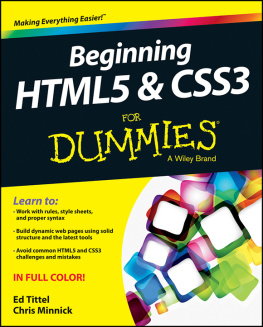
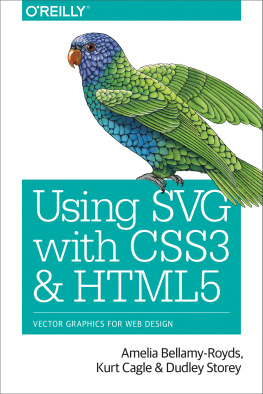

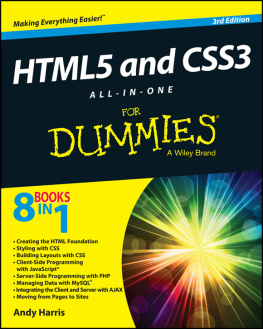
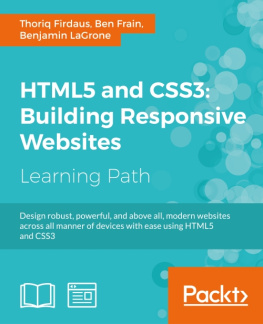
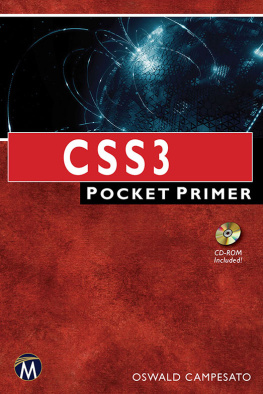




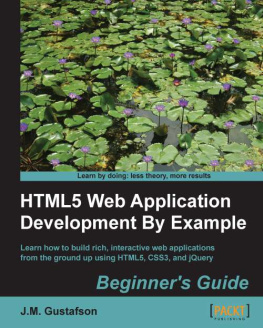

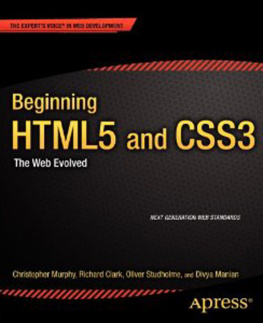


 Understanding web page structure and organization
Understanding web page structure and organization